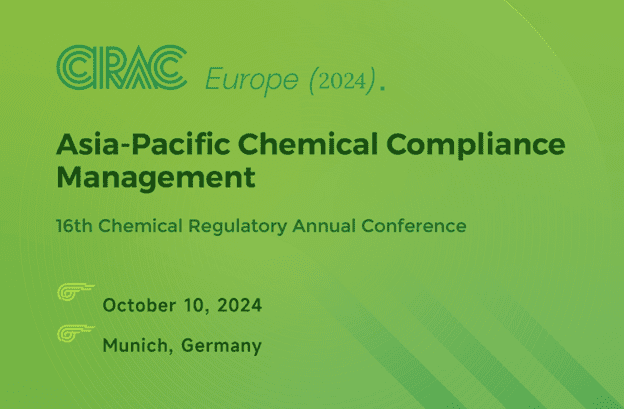
Highlights From CRAC Europe 2024

This blog was originally posted on 15th October, 2024. Further regulatory developments may have occurred after publication. To keep up-to-date with the latest compliance news, sign up to our newsletter.
AUTHORED BY DIEUDONNE YMEDJI, SENIOR REGULATORY COMPLIANCE SPECIALIST, COMPLIANCE & RISKS
Key Takeaways from CRAC Europe 2024
The 16th edition of REACH24H Consulting Group Chemical Regulatory Annual Conference (CRAC) took place in Munich on Thursday, 10 October 2024.
Presenters during the one-day event shed light on the complexities of chemical compliance, particularly in the context of chemicals regulations that affect market access in the Asia-Pacific region. The discussions covered various regulatory compliance frameworks and how they can be navigated effectively by businesses looking to enter or expand in this region’s key markets.
Topics discussed include:
- China New Chemical Substance Registration
- Strategy for Taiwan PEC Standard Registration
- Introduction to India Draft CMSR and BIS Regulations
- Chemical Regulatory Landscape and Updates in the Asia Pacific Region
China New Chemical Substance Registration
The first speaker of the day, Ms. Lyla Zhao, a Senior Regulatory Consultant at REACH24H, provided the audience with a comprehensive overview of China’s new chemical registration under MEE Order No. 12, with particular focus on the types of chemical registration (record notification, simplified registration, and regular registration).
Discussions revolved also around the:
- Scope of applicable substances and exemptions,
- Complexities of the polymer record notification rules, related post-registration obligations (i.e., annual report, standardization of data transmission, notification of new environmental hazards to competent authorities, retention, and management of new chemical substances),
- Case studies with sanctions for non-compliance.
Taiwan PEC Substances Standard Registration
The second presentation, provided virtually by Ms. Yahui Ni, General Manager of Environmental Resource International Co. Ltd. in Taiwan, discussed the registration process for the manufacture or import of new and existing chemical substances under Taiwan Regulation on New and Existing Chemical Substances Registration as revised in November 2023. It placed significant emphasis on the approaching extended registration deadline of 31 December 2024 for the 106 Priority Existing Chemical Substances (PEC) first batch. Companies involved in the manufacture or import of these substances are required to submit detailed registration dossiers specifying the properties, uses, and potential hazards for each PEC they manufacture or import in quantities of 1/ton or more per year. Failure to adhere to these requirements before the December deadline may result in the prohibition of sales for the unregistered substances and fines ranging between NT$30,000 to NT$300,000.
India Draft CMSR and BIS Regulations
The Indian fifth draft chemicals management and safety rules (CMSR) released since August 2020 (and not yet finalized), represents a crucial step in India’s efforts to modernize its chemical management policies by aligning them with international standards and incorporating elements from other established chemical regulatory frameworks such as EU REACH and K-REACH.
It will replace the current existing rules on the manufacture, storage, and import of hazardous chemical rules of 1989 and the 1996 chemical accidents (emergency planning, preparedness, and response) rules. The draft rules regulate substances on their own, substances in mixtures, substances in articles, and intermediates that are manufactured, imported, or placed in India above 1 ton per year. Indian manufacturers, importers, and authorized representatives for non-Indian legal entities shall comply with the CMSR by submitting notification, registration of their substances, and complying with other regulatory obligations.
The draft is still awaiting approval from the Indian central government. Following its adoption, it will be published in the official gazette and then notified to the WTO. This will mark its entry into force and the start of the countdown of the most important compliance deadlines, such as the:
- Initial notification period (which lasts for 6 months and starts 12 months after the ICMSR’s entry into force), and the
- Registration deadline of substances to be registered listed in Schedule II (18 months after the entry into force).
Regarding compliance strategies, Mr. Aman Sharma from REACH24H India reminded stakeholders to stay alert on any progress of the draft development and anticipate the upcoming rules implementation. To this effect, they shall start putting in place an in-house compliance team that will prepare an inventory of the substances they handled, identify the quantity they placed in the Indian market, initiate communication with downstream users, and review all hazard communication elements to ensure alignment with the global GHS latest edition and follow up on the relevant CMSR substance lists in Schedule II, Schedule VI (restricted and prohibited substances), and hazardous chemicals in Schedules X, XI, XII.
Besides the upcoming CMSR, businesses attention was also drawn to their obligations regarding:
- The mandatory BIS Certification for certain listed substances. Among other things, they shall ensure that they submit duly filled-in and complete applications along with the required fee and documentation to BIS to comply with the applicable standards, and the
- Indian Chemical Inventory platform (ChemIndia), which collects, compiles, and analyzes real-time data received from the chemicals and petrochemicals industry regarding the production, capacity, exports, imports, purchases, and sales of chemicals in India.
Chemical Regulatory Landscape and Updates in the Asia Pacific Region
Finally, Ms. Nadine He, Chemlinked editor-in-chief, provided an overview and current developments of Japan CSCL and ISHL, best practices sharing of joint registration processes and safety data sheet (SDS) submissions under K-REACH, Philippines RA 6969, Thailand Hazardous Substance Act, proposed revision of Vietnam law on chemicals, hazardous chemical import/export control, and registration enforcement in China, Australia AICIS, and IChEMS, as well as the state of GHS implementation in Asia Pacific countries. The emphasis on GHS changes covered:
China publication on 20 July 2024 of GB 30000.1-2024 Specification for classification and labelling of chemicals – Part 1: General rules adopting GHS Revision 8 and replacing existing general rules GB 13690-2009. The remaining 28 parts of GB 30000 (Parts 2-29) will be revised in due course.
Taiwan draft proposal aiming to align, by the end of this year, 21 out of the current 29 CNS 15030 series standards with the UN GHS Revision 8. This includes: CNS 15030 Classification and labelling of chemicals – General Rules; 10 physical hazards: CNS 15030.1~5, CNS 15030.7, CNS 15030.12, CNS 15030.14 to 16; and 10 health hazards: CNS 15030.17 to 26.
Japan’s proposals last month introducing changes to Article 18 of the ISHL Enforcement Order to expand the list of classified hazardous substances with the addition of 155 substances and the removal of 2 others to Schedule 2 of the ISHL implementing ordinance. Based on previous experience, it is anticipated that the adoption process will take up to two years to conclude.
Overall, the conference successfully achieved its objectives by providing participants with in-depth insights and knowledge on the regulatory developments and practices for the safe management of chemicals across the APAC region.

Stay On Top Of Your Changing Regulatory Obligations
Tell us your compliance challenges and we will find the solution that’s right for you.


